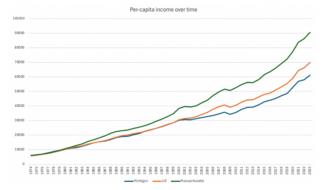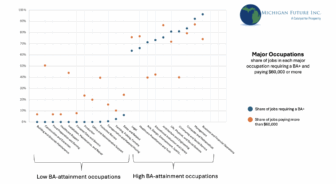
As we explored in our last post conventional wisdom about the value of a B.A. in obtaining a good-paying job and having a prosperous forty-year career is vastly underestimated. The Georgetown University Center on Education and the Workforce calculates that 59 percent of today’s good-paying jobs require a B.A. and that will grow to 66 percent in 2031.
The stories that dominate the public conversation about the labor market are not only inaccurate in their portrayal of the value of a B.A. compared to sub B.A.credentials, but also in its description of which occupations provide the most good-paying jobs. Conventional wisdom has it that good-paying jobs are narrowly focused in the skilled trades and in STEM occupations. Not close to reality both today and tomorrow.
The reality is that there are a wide variety of good-paying jobs now and as projected by the Center on Education and the Workforce will be a decade from now. As you can see below, management is, by far, the occupation cluster with the most good-paying jobs. Computer and math occupations are the largest STEM occupation cluster and it ranks the seventh largest. The largest skilled trades occupation cluster is construction and extraction ranking eight.
In the Michigan Future analysis of good-paying jobs we pull out first-line supervisors from all the occupation groups. If you do that, the proportion of good-paying management jobs goes up substantially. We found that first-line supervisors are the largest good-paying jobs occupation among jobs that don’t require a B.A.
Here are the proportions of good-paying 2031 jobs by occupation in the Georgetown report. Only those occupations that have at least 3 percent of all good-paying jobs are listed. A far more diverse list of occupations than conventional wisdom.
- Management: 21%
- Business and finance: 9%
- Healthcare professional and technical 9%
- Education, training and library: 7%
- sales: 7%
- Office and administrative support: 7%
- Computer and math: 6%
- Construction and extraction 5%
- Transportation and materials moving: 4%
- Production: 4%
- Architecture and engineering: 3%
- Installation, maintenance and repair: 3%
How many parents and students do you think know that there are more good-paying jobs projected in 2031 in both sales and office and administrative support than either construction or computers?
If we’re serious––as we should be––about providing all students information about all good-paying occupations we will have to dramatically change the story we are telling them about what the labor market today and tomorrow looks like. We need a reality based story about a labor market where there are a wide variety of good-paying job opportunities. Where the path to a prosperous career is not narrowly focused on either a STEM degree or learning a skilled trade. And where a four-year degree in any major is the most reliable path to the middle class.







